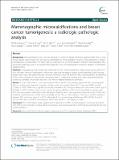| dc.contributor.author | Naseem, Madiha | en_US |
| dc.contributor.author | Murray, Joshua | en_US |
| dc.contributor.author | Hilton, John F | en_US |
| dc.contributor.author | Karamchandani, Jason | en_US |
| dc.contributor.author | Muradali, Derek | en_US |
| dc.contributor.author | Faragalla, Hala | en_US |
| dc.contributor.author | Polenz, Chanele | en_US |
| dc.contributor.author | Han, Dolly | en_US |
| dc.contributor.author | Bell, David C | en_US |
| dc.contributor.author | Brezden-Masley, Christine | en_US |
| dc.date.accessioned | 2015-05-04T15:27:42Z | |
| dc.date.issued | 2015 | en_US |
| dc.identifier.citation | Naseem, Madiha, Joshua Murray, John F Hilton, Jason Karamchandani, Derek Muradali, Hala Faragalla, Chanele Polenz, Dolly Han, David C Bell, and Christine Brezden-Masley. 2015. “Mammographic microcalcifications and breast cancer tumorigenesis: a radiologic-pathologic analysis.” BMC Cancer 15 (1): 307. doi:10.1186/s12885-015-1312-z. http://dx.doi.org/10.1186/s12885-015-1312-z. | en |
| dc.identifier.issn | 1471-2407 | en |
| dc.identifier.uri | http://nrs.harvard.edu/urn-3:HUL.InstRepos:15034983 | |
| dc.description.abstract | Background: Microcalcifications (MCs) are tiny deposits of calcium in breast soft tissue. Approximately 30% of early invasive breast cancers have fine, granular MCs detectable on mammography; however, their significance in breast tumorigenesis is controversial. This study had two objectives: (1) to find associations between mammographic MCs and tumor pathology, and (2) to compare the diagnostic value of mammograms and breast biopsies in identifying malignant MCs. Methods: A retrospective chart review was performed for 937 women treated for breast cancer during 2000–2012 at St. Michael’s Hospital. Demographic information (age and menopausal status), tumor pathology (size, histology, grade, nodal status and lymphovascular invasion), hormonal status (ER and PR), HER-2 over-expression and presence of MCs were collected. Chi-square tests were performed for categorical variables and t-tests were performed for continuous variables. All p-values less than 0.05 were considered statistically significant. Results: A total of 937 patient charts were included. About 38.3% of the patients presented with mammographic MCs on routine mammographic screening. Patients were more likely to have MCs if they were HER-2 positive (52.9%; p < 0.001). There was a significant association between MCs and peri-menopausal status with a mean age of 50 (64%; p = 0.012). Patients with invasive ductal carcinomas (40.9%; p = 0.001) were more likely to present with MCs than were patients with other tumor histologies. Patients with a heterogeneous breast density (p = 0.031) and multifocal breast disease (p = 0.044) were more likely to have MCs on mammograms. There was a positive correlation between MCs and tumor grade (p = 0.057), with grade III tumors presenting with the most MCs (41.3%). A total of 52.2% of MCs were missed on mammograms which were visible on pathology (p < 0.001). Conclusion: This is the largest study suggesting the appearance of MCs on mammograms is strongly associated with HER-2 over-expression, invasive ductal carcinomas, peri-menopausal status, heterogeneous breast density and multifocal disease. | en |
| dc.language.iso | en_US | en |
| dc.publisher | BioMed Central | en |
| dc.relation.isversionof | doi:10.1186/s12885-015-1312-z | en |
| dc.relation.hasversion | http://www.ncbi.nlm.nih.gov/pmc/articles/PMC4407616/pdf/ | en |
| dash.license | LAA | en_US |
| dc.subject | Microcalcifications | en |
| dc.subject | Breast imaging | en |
| dc.subject | Mammography | en |
| dc.subject | Tumorigenesis | en |
| dc.subject | Breast pathology | en |
| dc.subject | HER-2 | en |
| dc.title | Mammographic microcalcifications and breast cancer tumorigenesis: a radiologic-pathologic analysis | en |
| dc.type | Journal Article | en_US |
| dc.description.version | Version of Record | en |
| dc.relation.journal | BMC Cancer | en |
| dc.date.available | 2015-05-04T15:27:42Z | |
| dc.identifier.doi | 10.1186/s12885-015-1312-z | * |


